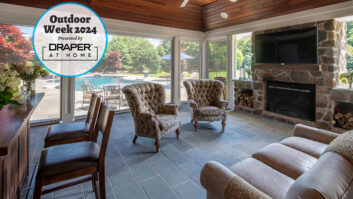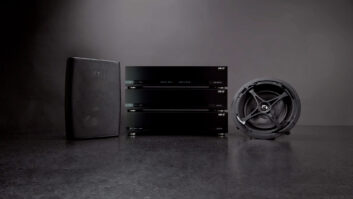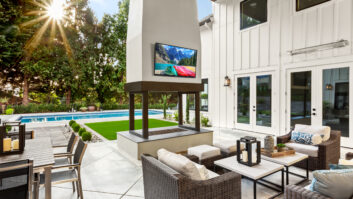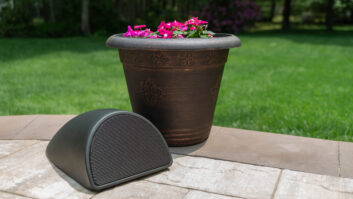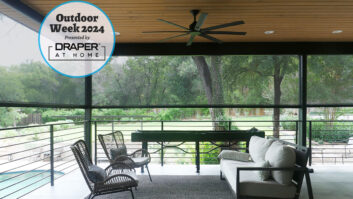Kudos: Amp seems truly weatherproof; wide dispersion of audio with impressive bass performance
Concerns: MSE OS-App control can be a little fussy; speakers have a bit of strain at higher volumes
As I write this, summer is in full swing. Days are lasting longer, the weather is nice, and people are spending more time outside either catching rays by the pool, grilling on the deck, or just chilling and enjoying the great wide open. And what improves outdoor living better than having some tunes either filling in the background during a quiet hang-out or taking center stage during a party?
I’ve been in this industry more than 20 years, and it has been interesting to follow the slow evolution of “outdoor audio” during that time. For a while, rock speakers were all the rage. Get one of the colors — brown, grey, sandstone — that most closely matched the environment, and then strategically place as many rocks as the budget would allow around the listening area(s). Or you’d just hang some “all weather” speakers off an eave, wall, fence, or post and aim them towards the main areas.
One of the biggest improvements for outdoor audio in recent years has been the landscape audio systems pioneered by companies like James Loudspeaker and Sonance, and now available in some form by just about everyone. These systems adopt the commercial model of using 70-volt amplification to drive lots of speakers at lower overall volumes, but delivering far more even coverage across large areas. Plus, they include a subwoofer (or several) to produce some true low-frequency bass information that delivers a far more impressive listening experience.
But one of the challenges all these systems face is wiring; all of them require getting some amount speaker wiring back to a weatherized location where you have an amplifier and source components. During construction, sure, it’s no problem, but in an existing home this could be a Sisyphean task, leading many homeowners to just bag it and go with some wireless or Bluetooth speaker they set on a counter.
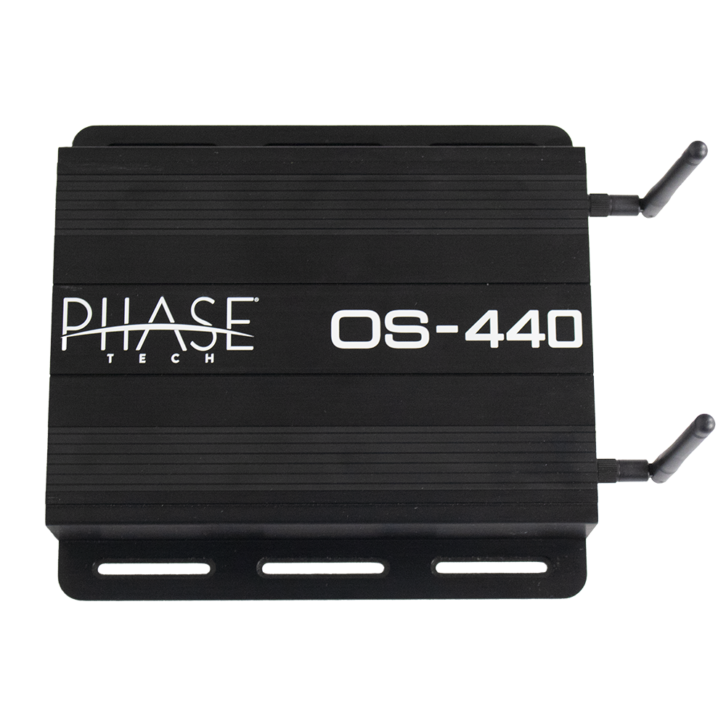
Fortunately, MSE Audio has developed an ideal solution to this problem in the form of the new OS-440, billed as the industry’s first outdoor smart amplifier. While MSE Audio might not be a familiar name to you, you’ll definitely have heard of a number of the companies that fall under its ownership umbrella, including dARTS, Induction Dynamics, Phase Technology, Rockustics, and more. (My review of the dARTS 535 audio system can be found here.)
The OS-440 is manufactured by Phase Technology and is a fully-contained amplifier and audio streamer with built-in Google Chromecast that is meant to live outside. Simply pick a convenient location where there is power, the ability to run speaker wiring, and a decent WiFi signal, and you’re in business. And, while definitely preferred, the WiFi part is technically optional as the OS-440 supports Bluetooth streaming, offers a WiFi direct mode, and has both analog RCA and Toslink digital audio inputs for connecting a separate source such as an outdoor TV.
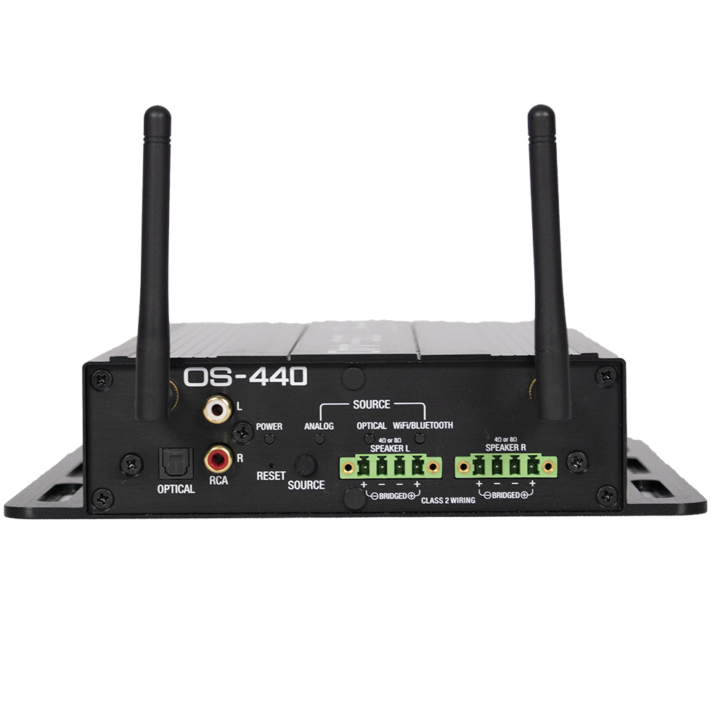
As the perfect complement to this amplifier, MSE also sent a pair of Cherry Bomb (CB5) speakers that were unveiled at this past CEDIA by sister-brand Rockustics. Rockustics pioneered the rock speaker, so they know a thing or three about outdoor audio, and these new speakers are a three-way design, featuring a 5-inch double-chamber bandpass subwoofer, a 4-inch woofer, and .75-inch titanium tweeter all in one housing. It also features a distinctive bright red base, thus the “Cherry Bomb” moniker. Sold as singles (rather than in pairs), the CB5 can operate in either 8-ohm or 70-volt applications.
Opening the OS-440’s box reveals a daunting number of accessories, as well as three separate installation manuals: a set-up guide, a water-resistant parts guide, and an app guide. These manuals definitely come in handy as they explain how to correctly use all the miscellaneous connectors and weather kit to achieve the OS-440’s IP55 rating that allows it to survive the elements.
Connection-wise, the OS-440 can power four speakers at 40 watts/channel, or be bridged to drive a pair of speakers at 80 watts/channel. As I had only two CB5’s, I ran it in bridged mode. There are also two Tri-band antennas for Bluetooth and WiFi reception as well as the aforementioned analog and digital inputs. The amp has a source selection button and some LED indicators; however, these will likely rarely see use in practice as they are inaccessible once the weatherized kit has been attached and that is not something you will want to just pull on and off. The amp can be wall-mounted or simply placed on a flat surface.
Once everything is connected and the weatherized seals are installed, you download the MSE OS-App (Android and iOS versions available) to complete setup. This allows you to name the connected speakers, connect the OS-440 to an available WiFi (2.4 or 5 GHz) network, adjust bass and treble, select 4-channel or Bridge mode, and so on. The app can also be used to switch sources between RCA, Optical, and Bluetooth, select Local Content for playback, or browse content from a DLNA server on the local network, and is used to group multiple OS-440’s together in large installations.
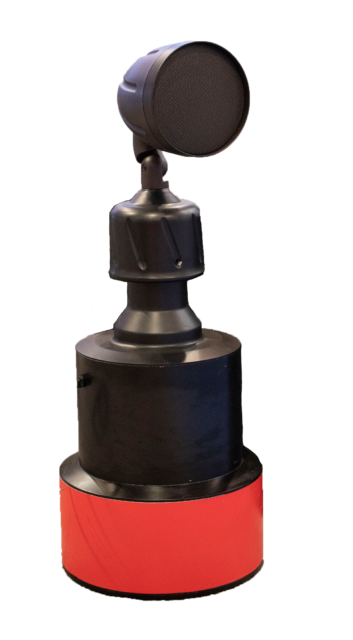
The lower half of each Cherry Bomb speaker is meant for in ground burial for permanent installs. This would conceal its striking red base and greatly reduce the overall size and formfactor of the speaker, making for a more “landscape friendly” look. However, Rockustics said the speaker performs equally well freestanding, so that’s the route I took.
The Cherry Bombs do have a bit of idiosyncrasy in their wiring connections. There are blue and yellow wires for 70-volt operation, connecting to the speaker’s 64-watt transformer. There are also oddly four wires for 8-ohm operation; a green-and-red pair and a white-and-black pair. The green is used for positive and the white for negative, with the red and black unused. Why Rockustics would veer from the industry accepted color codes — or include an extra set of unused wires — is an answer I don’t have.
Since the OS-440 uses Chromecast, there are a variety of options for streaming music to it. App-wise, Chromecast supports the majority of biggies, including Pandora, Google Play Music, Spotify, Tidal, iHeartRadio, Napster, and TuneIn. Similar to how AirPlay and Spotify Connect work, you open the streaming app you’d like to use, then select the speaker you want to Cast to. I have a pretty robust Luxul WiFi network, and I never had any streaming issues. For services not supported by Chromecast (or when no WiFi network is available), a customer could connect to the OS-440 via Bluetooth.
The OS-440 definitely acquitted itself of any concerns about its durability and capability of withstanding the elements from the get go. Not five minutes after I installed it, my wife watered some plants directly above where I installed the amp and it got soaked. The amp shrugged it off. Myrtle Beach, SC in the summer can be a ruthless location for people, let alone electronics, but the amp has handled months’ worth of weather that has included afternoon thunderstorms, brutal humidity, and 100-plus-degree temps like a boss. I’ve had it playing long hours in baking temps with nary a hiccup or blip in performance. (For the record, the OS-440 is rated for –20–150-degree Fahrenheit operating temps.)
Review: Roon Labs Nucleus Music Server
Audio performance from the Cherry Bomb’s was likewise impressive, with sound quality more resembling a quality, full-range traditional tower loudspeaker than any outdoor model. I listened to hours’ worth of music over the months I had the CB5’s installed, and they consistently delivered the goods on all genres. Bass from the bandpass subwoofer was not only deep, but textured, letting you appreciate Geddy Lee’s complex bass work on “YYZ.” “Flight of the Cosmic Hippo” from Bela Fleck and the Flecktones is another great bass test track, and the CB5’s showed it was up to the task, delivering all the layers of the deep synth bass line. The speakers are rated to play –10 dB at 42 Hz, and The Crystal Method’s “High Roller” showed that, while they play the big bass notes, they didn’t have the kick of a system that includes a true powered subwoofer. Still, they were able to generate bass notes that you could feel while floating around in the pool, which I consider a definite win.
They also produced detailed midrange and bright highs courtesy of the titanium tweeter. Vocals were always clear and distinct, and cymbals like on Hank Mobley’s “Dig Dis” had the appropriate amount of snap and air. “Rey’s Theme” from Star Wars: The Force Awakens is one of my favorite works by John Williams, and the CB5’s treated the delicate instrumentation with the proper amount of care.
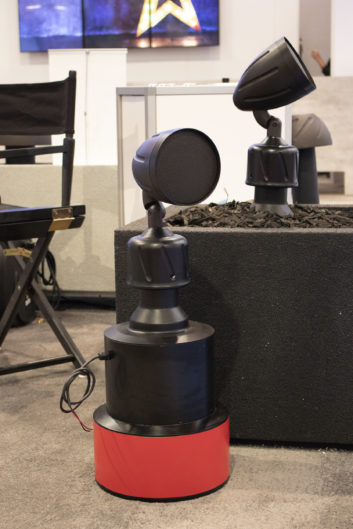
I did notice that as I started pushing the volume level up in the range that mids and highs started to sound strained. Wayne Shorter’s trumpet on “Lady Day,” for example, started leaning towards shrill as volumes crested 50 percent.
The only operational issues I had were all app and control based, many of which were a learning curve on my part. The MSE OS-App can’t do anything with the speaker while a Casting session is in progress. So, doing anything — changing the volume, adjusting bass/treble, picking a different source — requires you to first disconnect any Casting in progress. When using Google Play, the speaker would “time out” after not using the app for a bit; and while music would continue playing, I would have to reconnect to it in order to control it. And sometimes the Google Home app would “see” the speaker, but not allow me to connect with it and control it.
Perhaps the most impressive thing about this combination is the price. With the amp selling for under $500 and the Cherry Bombs at $649/each, customers of all budgets can assemble a truly stellar, full-range outdoor audio system. Plus, the amplifier’s installation location flexibility will save additional on wiring and labor and open up additional sales opportunities that might not have existed otherwise.
Want more stories like this delivered to your inbox every day? Then sign up for the free Residential Systems eNewsletter here.
——————————————————————
855-663-5600; mseaudio.com
Product Specs – Rockustics Cherry Bomb (CB5)
- 3-way design featuring 5.25-inch double-chamber, bandpass subwoofer, 4-inch mid/bass driver, and .75-inch Titanium dome tweeter
- 8-ohm or 70-volt operation with included internal 64-watt tap
- 50 Hz–20 kHz (±3 dB) frequency response
- 100-watts max power; 100 dB SPL at 1-meter at max power
- Sensitivity 83 dB (1-watt at 1-meter)
- Speaker head tilts and pans for optimal positioning
Dimensions: 26.50 x 10.63-inches (Height x Diameter at base); 15.6 pounds
Product Specs – Phase Technology OS-440
- 2/4-channel operation; 4×40 watts, bridgeable to 2×80 watts
- Google Chromecast built-in with DLNA server
- Bluetooth and WiFi Direct modes
- RCA analog and Toslink optical digital audio inputs
- Includes Outdoor Weatherize Kit to achieve IP55 rating
- Controlled via MSE OS-App (Android and iOS versions available)
Dimensions: 1.75 x 8 x 9.75-inches (HxWxL); 3.74 pounds
